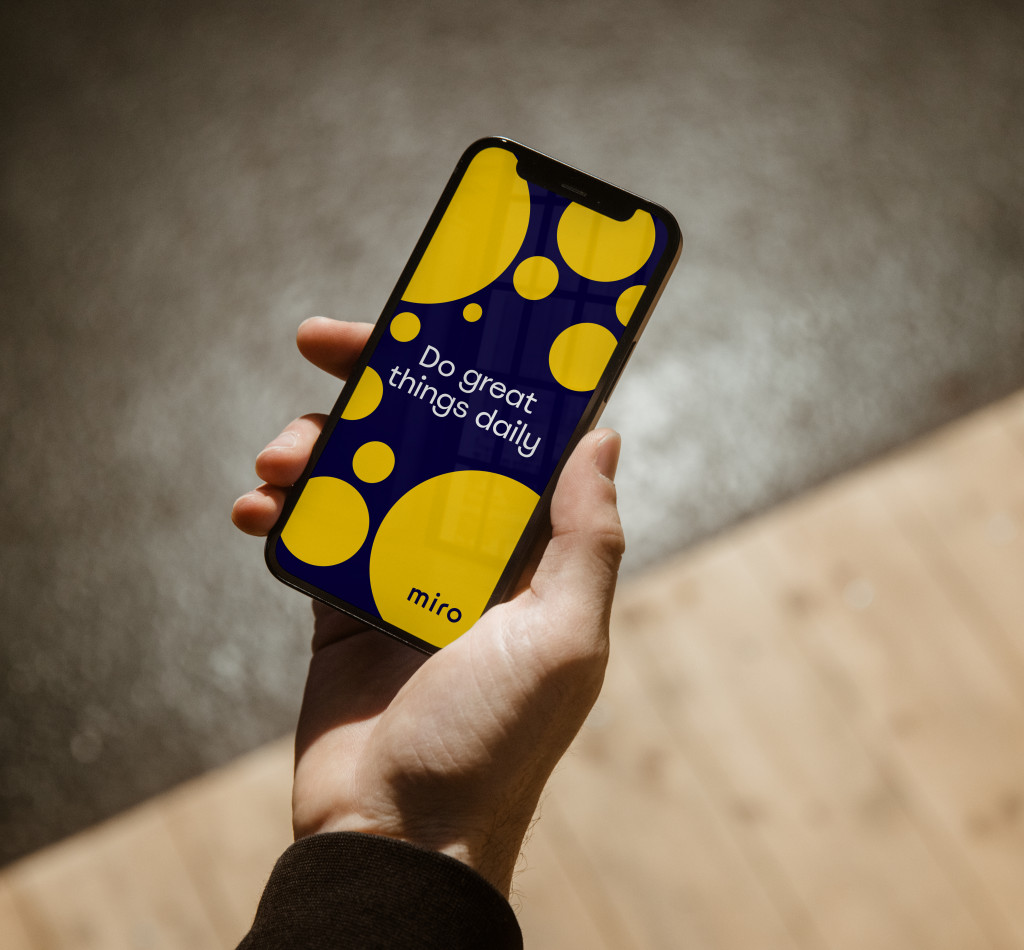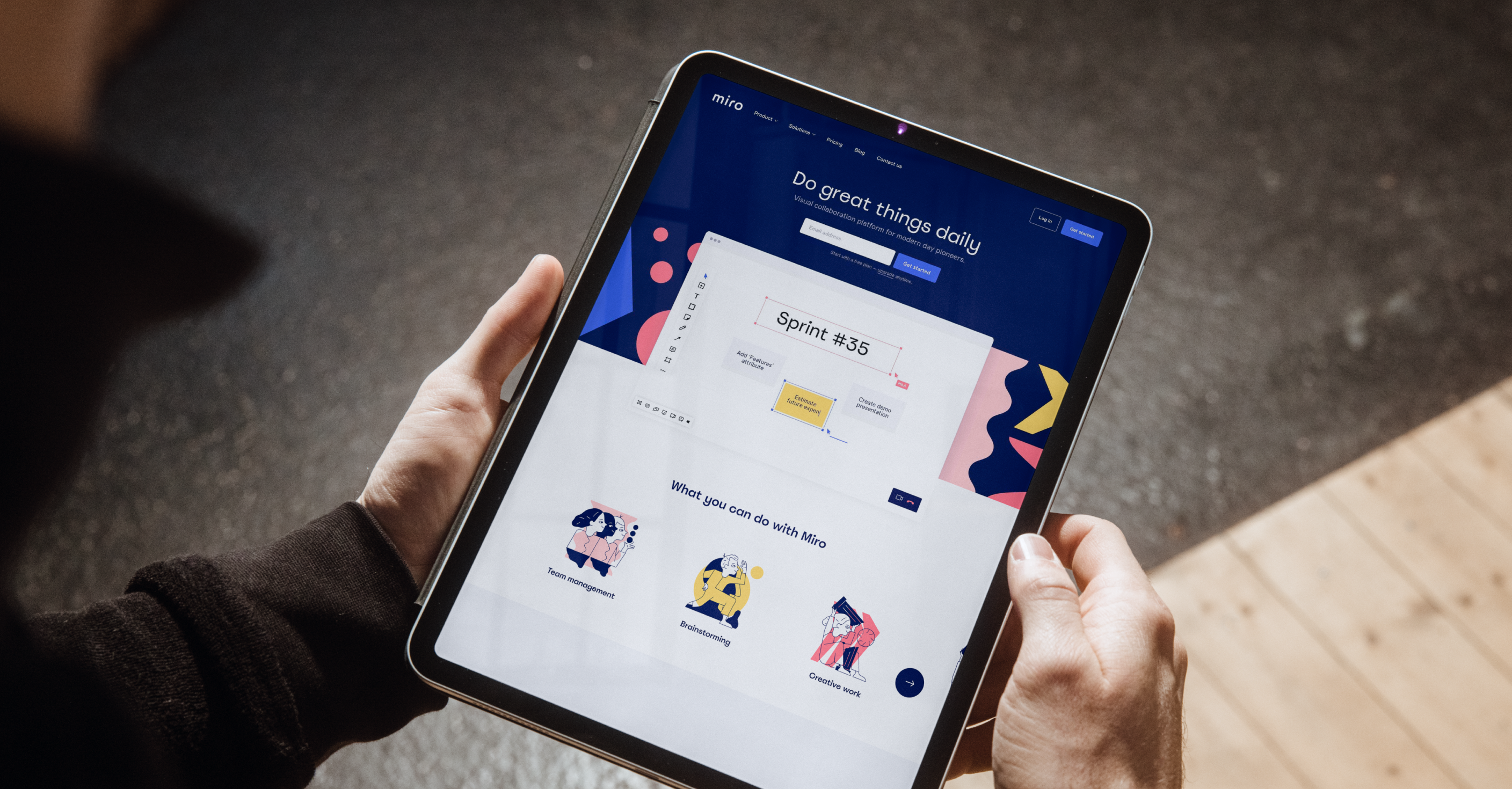Two years have passed since the rebranding of Miro. Since then, the popular tech scale-up and online collaboration tool jumped from 2,5 to more than 25 million users worldwide. Today, we’re reflecting on the process with Yegor Korobeynikov, Head of Strategic Brand Activations at Miro. What makes branding essential, especially for a tech scale-up? And what are the lessons learned looking back?

In just six weeks, RealtimeBoard rebranded into Miro. How do you look back at the rebranding process now?
I believe branding for tech companies should be treated as a product. As a product organisation, you are working on a weekly basis iterating and learning from feedback. However, branding processes often take up a whole year, without proof of concepts, feedback or insights and being able to learn from them. The way I see it, is that you should be working on branding with a product mindset, without such a disparity of pace.
We decided to go for Verve, because we were looking for a branding agency that could move just as fast as we do. With an agile branding process, design sprints, and working remotely (in Miro) we overcame physical boundaries and time limits together.
Ask yourself: ‘How can I help my customers become better versions of themselves?'
What do you think is the essence of branding?
Often when we talk about branding, we talk about visual assets, identity, colour, typography, logo and things like that. But that’s not branding, that’s visual design.
I think the essence of branding is to change this mindset and think holistically. Leave your ivory tower, talk to your audience, and ask yourself: ‘How can I help my customers become better versions of themselves?’.
Try to understand what your customer needs and understand for which job they hire you as a brand, and to what situations of their life you can help them. Be helpful and supportive, and invest in relationships.
Every brand should have its own brand story and should shape its brand experience in a way that aligns with that story. Branding is the roadmap you can follow to increase your market share, and it enhances your customers’ feelings and experiences when interacting with your brand.

What are the biggest challenges of launching a brand internally?
One of the biggest challenges when launching your brand at scale is to support your promise across all teams in your company. From the sales team to designers, everyone has to make sure your brand is visually and verbally consistent.
You want to be clear and unambiguous: every time you’re developing customer-facing assets you have an opportunity to represent your brand. And if the quality of those assets is not right, people might get the wrong impression. It’s all assets combined that create a general perception of your brand.
The branding industry should do a ‘rebrand of branding’.
How do you convey the importance of branding across the company?
Branding is a business asset. It’s an opportunity to articulate your brand's promise and narrative and lead people to the destination you want them to reach. It’s about how you think about the long term strategy.
At some point, product features become a commodity you can’t compete with. Therefore, if you want to be a competitive company with a strong business footprint you need to invest in your brand.
The biggest work we all need to do in the branding industry is to do a ‘rebrand of branding’. We need to change the perception and the role of branding and show that it helps businesses achieve their goals. Brand teams should become part of the leadership team.

In the last year working from home became the new standard. How did this affect your business focus?
Last year changed everything, our audience expanded dramatically. Basically, the whole market of knowledge workers, which is now 1 billion people globally, became our potential users. This was amazing news, but it also brought a lot of challenges.
Miro made a shift from nice-to-have to a must-have tool. While scaling the infrastructure and supporting the large demand we want to keep the tool affordable and easy to use. We wanted to develop a product that helps everyone, from accountants to engineering managers, to do their work. But how do you speak to such a diverse audience?
We focused on how we can help people and teams to embrace this new normal. How can Miro enable you to do your work in the best way? Are there actionable things we can help with? These questions helped our audience see using Miro not as a challenge, but as an opportunity.
For the same reason, we’ve been focusing on our online community across our socials and via our own community platform. Because collaborating remotely was new for the majority of people, it was great to have a place where people could share their experiences and give each other advice.
Another thing that worked really well for us is online events, we host virtual Miro user groups online and organized a virtual conference, which attracted 30.000 registrants last year. It was a good way to bring thought leaders, experts of Miro, and business leaders together and give new users an opportunity to learn from them.

Which developments do you foresee in the future of branding?
One of the biggest shifts that is happening is the transition from feature marketing to benefit marketing. Brands should talk about what value they bring to the audience and stop focusing on their features. They should invest in storytelling and explore new territories. Nike has been doing this for quite a while, followed by brands like Oatly, Tony Chocolony and Spotify.
A good example is Mailchimp’s strategy. They buy licensed short films, are making podcasts series about topics varying from noodle making to business insights, and create a magazine for entrepreneurs.
Brands should make sure their (potential) audience spends as much time as possible with them. The only way they can do that is to do something that brings value to them. This way, people can make a connection with you and will start to trust you more.
Brands should talk about what value they bring to the audience and stop focusing on their features.
The second trend I’m seeing is that more and more companies are investing in branding in a broader sense. Tech companies like Dropbox, Figma, Wetransfer and Squarespace invest a lot in their branding because they understand there are very few competitive advantages left. Building a brand helps you stand out from the competition. It helps people navigate when they’re choosing between 200 applications in the same category, for example.
The third and last one is that companies that invest in branding, start to build their in-house studios. This gives them better insights, collaboration opportunities and allows them to ship things to the market faster and quicker. This gives agencies the opportunity to add value in a completely new way.
Check out our work for Miro, awarded with two European Design Awards.
